Big Data Technology's Role in Strategic Business Decisions
VerifiedAdded on 2023/06/07
|8
|1878
|292
Report
AI Summary
This report explores the role of big data in business decision-making, tracing its history from the 1880s to the present day. It defines big data, highlighting its characteristics (volume, variety, veracity, value, and variability) and the challenges associated with its analytics, such as time consumption, inaccurate data, complex structures, high maintenance costs, and poor data visualization. The report also discusses various techniques for analyzing big data, including data mining, machine learning, A/B testing, data fusion and integration, and statistics. Furthermore, it examines how big data technology can support businesses by providing better consumer perspectives, enabling smarter recommendations, enhancing industry intelligence, facilitating agile supply chain management, driving data-driven innovation, and diversifying the use of data sets. The report emphasizes the importance of big data in generating actionable insights for improved efficiency and profitability in various business functions.

Business decision
making
making
Paraphrase This Document
Need a fresh take? Get an instant paraphrase of this document with our AI Paraphraser
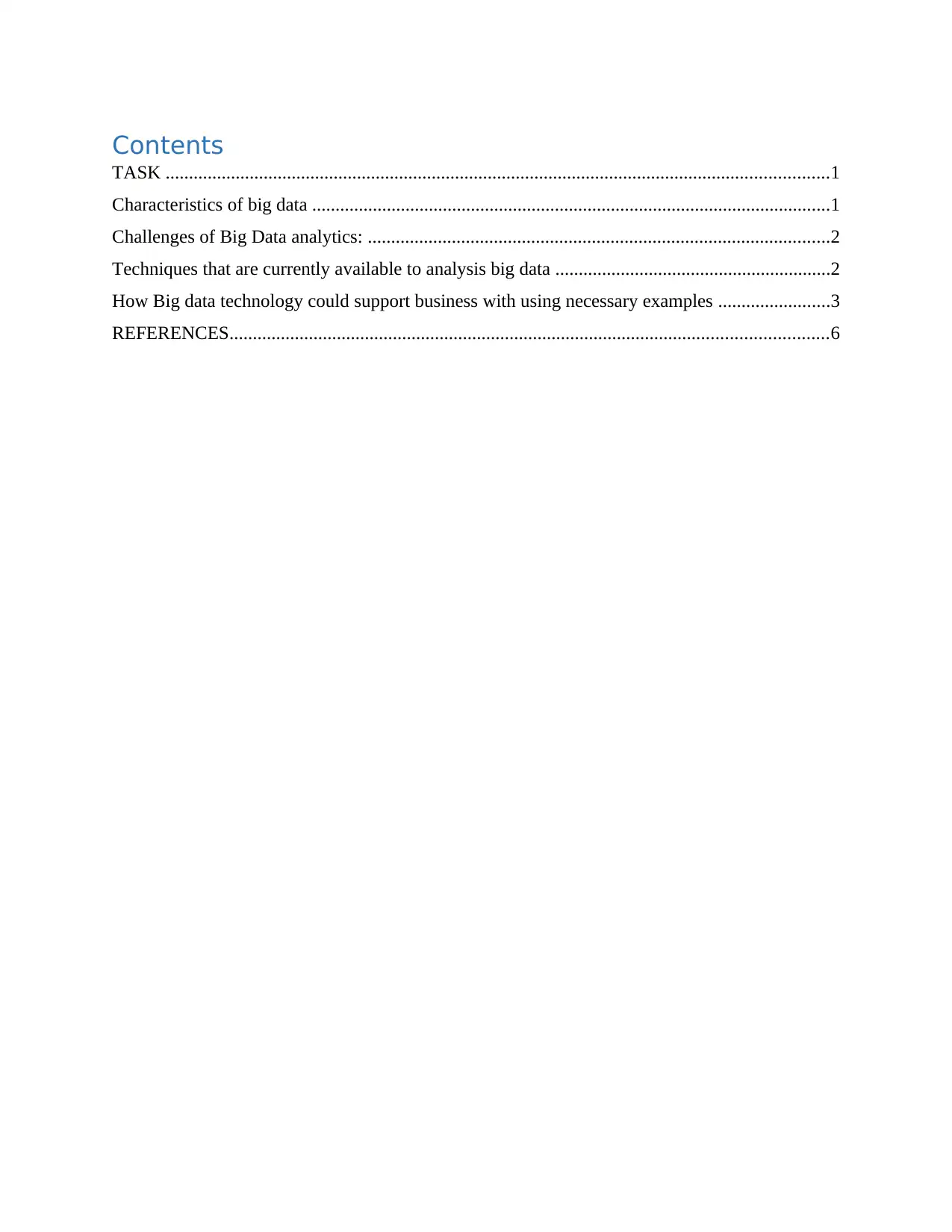
Contents
TASK ..............................................................................................................................................1
Characteristics of big data ...............................................................................................................1
Challenges of Big Data analytics: ...................................................................................................2
Techniques that are currently available to analysis big data ...........................................................2
How Big data technology could support business with using necessary examples ........................3
REFERENCES................................................................................................................................6
TASK ..............................................................................................................................................1
Characteristics of big data ...............................................................................................................1
Challenges of Big Data analytics: ...................................................................................................2
Techniques that are currently available to analysis big data ...........................................................2
How Big data technology could support business with using necessary examples ........................3
REFERENCES................................................................................................................................6
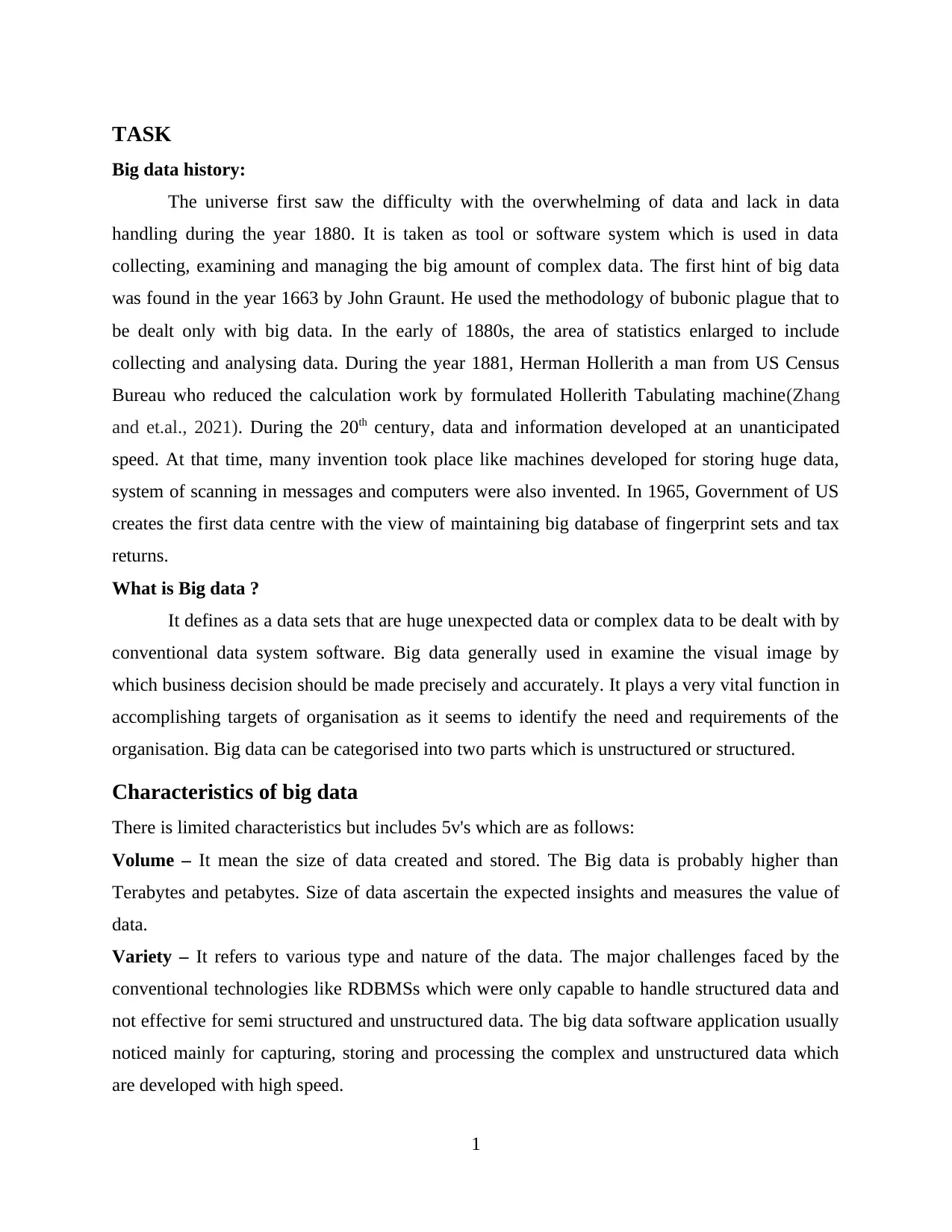
TASK
Big data history:
The universe first saw the difficulty with the overwhelming of data and lack in data
handling during the year 1880. It is taken as tool or software system which is used in data
collecting, examining and managing the big amount of complex data. The first hint of big data
was found in the year 1663 by John Graunt. He used the methodology of bubonic plague that to
be dealt only with big data. In the early of 1880s, the area of statistics enlarged to include
collecting and analysing data. During the year 1881, Herman Hollerith a man from US Census
Bureau who reduced the calculation work by formulated Hollerith Tabulating machine(Zhang
and et.al., 2021). During the 20th century, data and information developed at an unanticipated
speed. At that time, many invention took place like machines developed for storing huge data,
system of scanning in messages and computers were also invented. In 1965, Government of US
creates the first data centre with the view of maintaining big database of fingerprint sets and tax
returns.
What is Big data ?
It defines as a data sets that are huge unexpected data or complex data to be dealt with by
conventional data system software. Big data generally used in examine the visual image by
which business decision should be made precisely and accurately. It plays a very vital function in
accomplishing targets of organisation as it seems to identify the need and requirements of the
organisation. Big data can be categorised into two parts which is unstructured or structured.
Characteristics of big data
There is limited characteristics but includes 5v's which are as follows:
Volume – It mean the size of data created and stored. The Big data is probably higher than
Terabytes and petabytes. Size of data ascertain the expected insights and measures the value of
data.
Variety – It refers to various type and nature of the data. The major challenges faced by the
conventional technologies like RDBMSs which were only capable to handle structured data and
not effective for semi structured and unstructured data. The big data software application usually
noticed mainly for capturing, storing and processing the complex and unstructured data which
are developed with high speed.
1
Big data history:
The universe first saw the difficulty with the overwhelming of data and lack in data
handling during the year 1880. It is taken as tool or software system which is used in data
collecting, examining and managing the big amount of complex data. The first hint of big data
was found in the year 1663 by John Graunt. He used the methodology of bubonic plague that to
be dealt only with big data. In the early of 1880s, the area of statistics enlarged to include
collecting and analysing data. During the year 1881, Herman Hollerith a man from US Census
Bureau who reduced the calculation work by formulated Hollerith Tabulating machine(Zhang
and et.al., 2021). During the 20th century, data and information developed at an unanticipated
speed. At that time, many invention took place like machines developed for storing huge data,
system of scanning in messages and computers were also invented. In 1965, Government of US
creates the first data centre with the view of maintaining big database of fingerprint sets and tax
returns.
What is Big data ?
It defines as a data sets that are huge unexpected data or complex data to be dealt with by
conventional data system software. Big data generally used in examine the visual image by
which business decision should be made precisely and accurately. It plays a very vital function in
accomplishing targets of organisation as it seems to identify the need and requirements of the
organisation. Big data can be categorised into two parts which is unstructured or structured.
Characteristics of big data
There is limited characteristics but includes 5v's which are as follows:
Volume – It mean the size of data created and stored. The Big data is probably higher than
Terabytes and petabytes. Size of data ascertain the expected insights and measures the value of
data.
Variety – It refers to various type and nature of the data. The major challenges faced by the
conventional technologies like RDBMSs which were only capable to handle structured data and
not effective for semi structured and unstructured data. The big data software application usually
noticed mainly for capturing, storing and processing the complex and unstructured data which
are developed with high speed.
1
⊘ This is a preview!⊘
Do you want full access?
Subscribe today to unlock all pages.

Trusted by 1+ million students worldwide
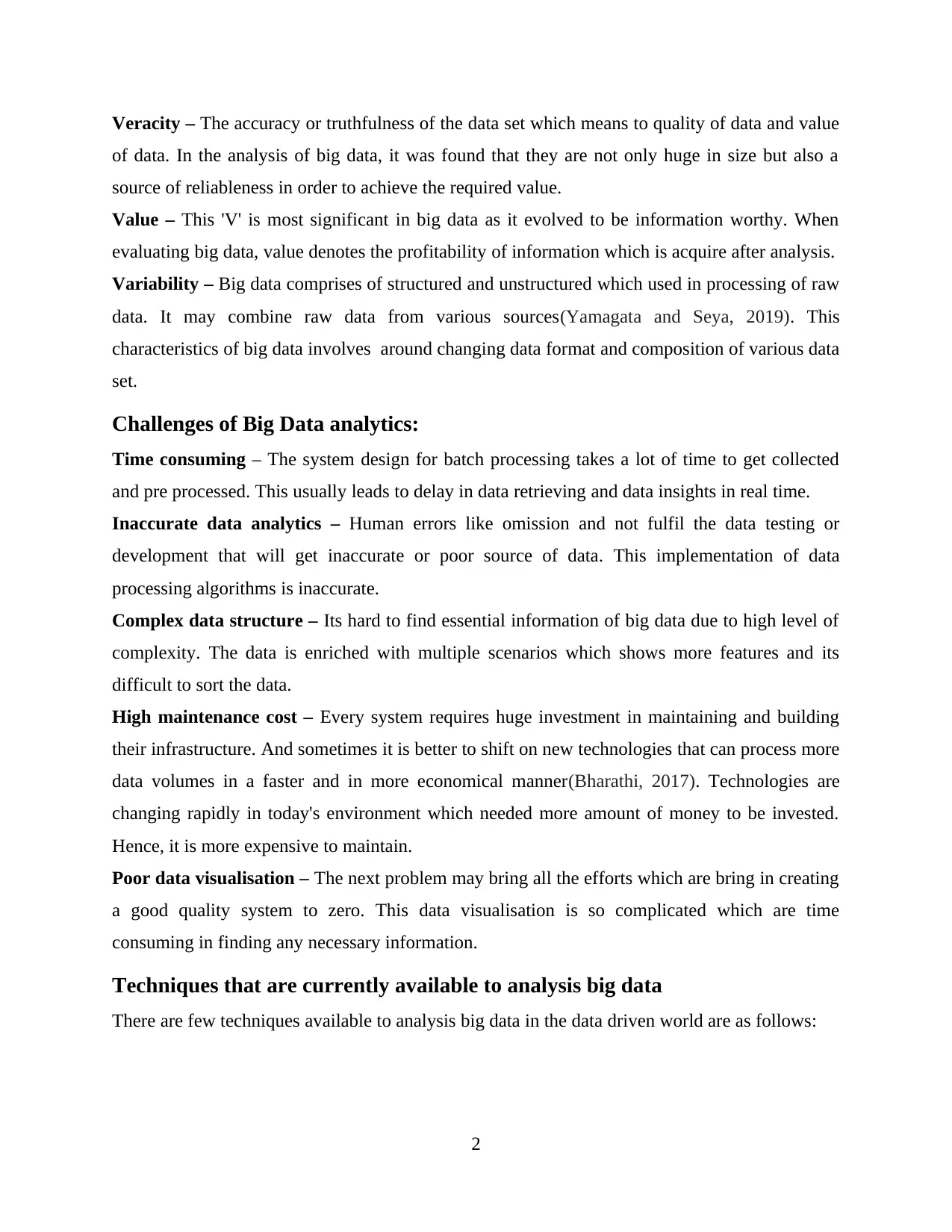
Veracity – The accuracy or truthfulness of the data set which means to quality of data and value
of data. In the analysis of big data, it was found that they are not only huge in size but also a
source of reliableness in order to achieve the required value.
Value – This 'V' is most significant in big data as it evolved to be information worthy. When
evaluating big data, value denotes the profitability of information which is acquire after analysis.
Variability – Big data comprises of structured and unstructured which used in processing of raw
data. It may combine raw data from various sources(Yamagata and Seya, 2019). This
characteristics of big data involves around changing data format and composition of various data
set.
Challenges of Big Data analytics:
Time consuming – The system design for batch processing takes a lot of time to get collected
and pre processed. This usually leads to delay in data retrieving and data insights in real time.
Inaccurate data analytics – Human errors like omission and not fulfil the data testing or
development that will get inaccurate or poor source of data. This implementation of data
processing algorithms is inaccurate.
Complex data structure – Its hard to find essential information of big data due to high level of
complexity. The data is enriched with multiple scenarios which shows more features and its
difficult to sort the data.
High maintenance cost – Every system requires huge investment in maintaining and building
their infrastructure. And sometimes it is better to shift on new technologies that can process more
data volumes in a faster and in more economical manner(Bharathi, 2017). Technologies are
changing rapidly in today's environment which needed more amount of money to be invested.
Hence, it is more expensive to maintain.
Poor data visualisation – The next problem may bring all the efforts which are bring in creating
a good quality system to zero. This data visualisation is so complicated which are time
consuming in finding any necessary information.
Techniques that are currently available to analysis big data
There are few techniques available to analysis big data in the data driven world are as follows:
2
of data. In the analysis of big data, it was found that they are not only huge in size but also a
source of reliableness in order to achieve the required value.
Value – This 'V' is most significant in big data as it evolved to be information worthy. When
evaluating big data, value denotes the profitability of information which is acquire after analysis.
Variability – Big data comprises of structured and unstructured which used in processing of raw
data. It may combine raw data from various sources(Yamagata and Seya, 2019). This
characteristics of big data involves around changing data format and composition of various data
set.
Challenges of Big Data analytics:
Time consuming – The system design for batch processing takes a lot of time to get collected
and pre processed. This usually leads to delay in data retrieving and data insights in real time.
Inaccurate data analytics – Human errors like omission and not fulfil the data testing or
development that will get inaccurate or poor source of data. This implementation of data
processing algorithms is inaccurate.
Complex data structure – Its hard to find essential information of big data due to high level of
complexity. The data is enriched with multiple scenarios which shows more features and its
difficult to sort the data.
High maintenance cost – Every system requires huge investment in maintaining and building
their infrastructure. And sometimes it is better to shift on new technologies that can process more
data volumes in a faster and in more economical manner(Bharathi, 2017). Technologies are
changing rapidly in today's environment which needed more amount of money to be invested.
Hence, it is more expensive to maintain.
Poor data visualisation – The next problem may bring all the efforts which are bring in creating
a good quality system to zero. This data visualisation is so complicated which are time
consuming in finding any necessary information.
Techniques that are currently available to analysis big data
There are few techniques available to analysis big data in the data driven world are as follows:
2
Paraphrase This Document
Need a fresh take? Get an instant paraphrase of this document with our AI Paraphraser
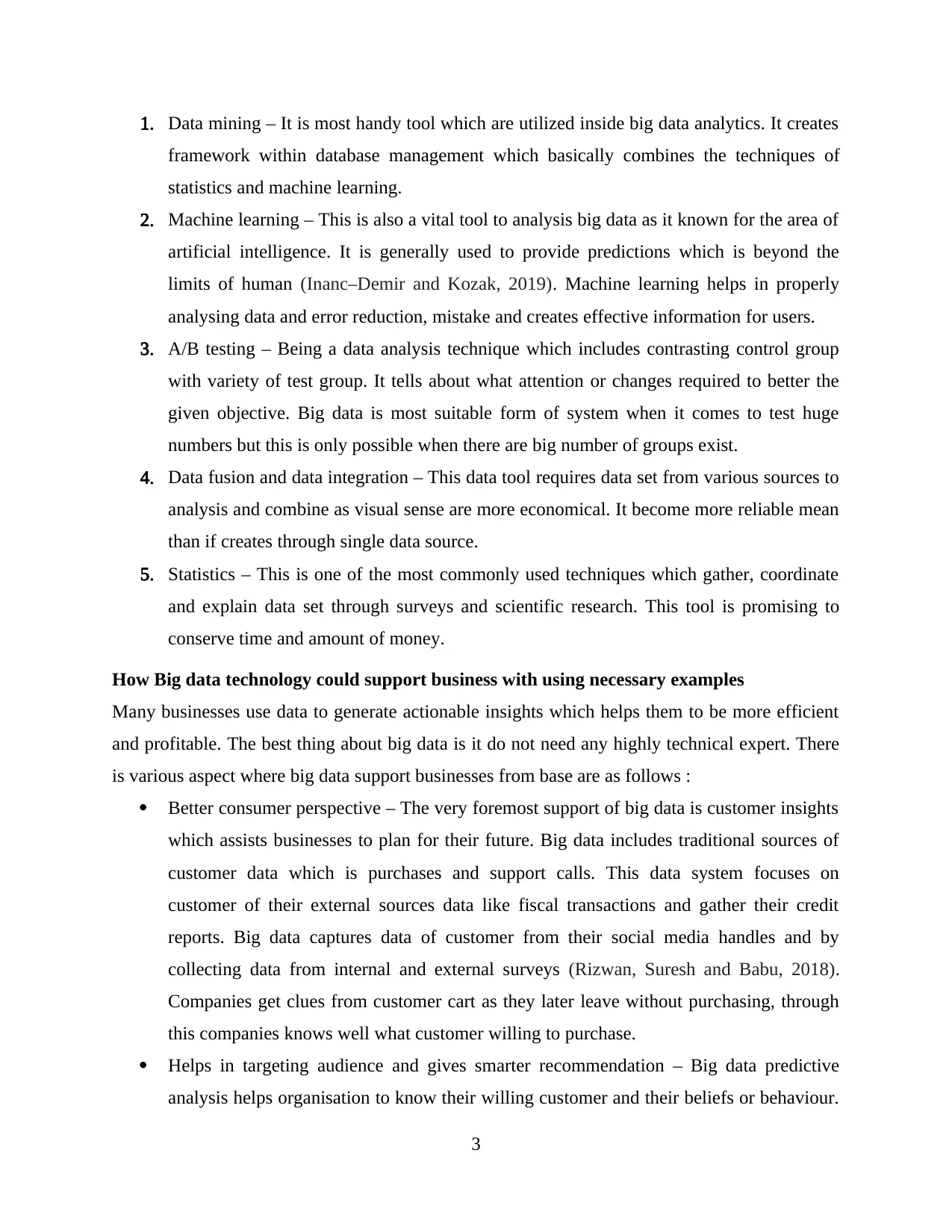
1. Data mining – It is most handy tool which are utilized inside big data analytics. It creates
framework within database management which basically combines the techniques of
statistics and machine learning.
2. Machine learning – This is also a vital tool to analysis big data as it known for the area of
artificial intelligence. It is generally used to provide predictions which is beyond the
limits of human (Inanc–Demir and Kozak, 2019). Machine learning helps in properly
analysing data and error reduction, mistake and creates effective information for users.
3. A/B testing – Being a data analysis technique which includes contrasting control group
with variety of test group. It tells about what attention or changes required to better the
given objective. Big data is most suitable form of system when it comes to test huge
numbers but this is only possible when there are big number of groups exist.
4. Data fusion and data integration – This data tool requires data set from various sources to
analysis and combine as visual sense are more economical. It become more reliable mean
than if creates through single data source.
5. Statistics – This is one of the most commonly used techniques which gather, coordinate
and explain data set through surveys and scientific research. This tool is promising to
conserve time and amount of money.
How Big data technology could support business with using necessary examples
Many businesses use data to generate actionable insights which helps them to be more efficient
and profitable. The best thing about big data is it do not need any highly technical expert. There
is various aspect where big data support businesses from base are as follows :
Better consumer perspective – The very foremost support of big data is customer insights
which assists businesses to plan for their future. Big data includes traditional sources of
customer data which is purchases and support calls. This data system focuses on
customer of their external sources data like fiscal transactions and gather their credit
reports. Big data captures data of customer from their social media handles and by
collecting data from internal and external surveys (Rizwan, Suresh and Babu, 2018).
Companies get clues from customer cart as they later leave without purchasing, through
this companies knows well what customer willing to purchase.
Helps in targeting audience and gives smarter recommendation – Big data predictive
analysis helps organisation to know their willing customer and their beliefs or behaviour.
3
framework within database management which basically combines the techniques of
statistics and machine learning.
2. Machine learning – This is also a vital tool to analysis big data as it known for the area of
artificial intelligence. It is generally used to provide predictions which is beyond the
limits of human (Inanc–Demir and Kozak, 2019). Machine learning helps in properly
analysing data and error reduction, mistake and creates effective information for users.
3. A/B testing – Being a data analysis technique which includes contrasting control group
with variety of test group. It tells about what attention or changes required to better the
given objective. Big data is most suitable form of system when it comes to test huge
numbers but this is only possible when there are big number of groups exist.
4. Data fusion and data integration – This data tool requires data set from various sources to
analysis and combine as visual sense are more economical. It become more reliable mean
than if creates through single data source.
5. Statistics – This is one of the most commonly used techniques which gather, coordinate
and explain data set through surveys and scientific research. This tool is promising to
conserve time and amount of money.
How Big data technology could support business with using necessary examples
Many businesses use data to generate actionable insights which helps them to be more efficient
and profitable. The best thing about big data is it do not need any highly technical expert. There
is various aspect where big data support businesses from base are as follows :
Better consumer perspective – The very foremost support of big data is customer insights
which assists businesses to plan for their future. Big data includes traditional sources of
customer data which is purchases and support calls. This data system focuses on
customer of their external sources data like fiscal transactions and gather their credit
reports. Big data captures data of customer from their social media handles and by
collecting data from internal and external surveys (Rizwan, Suresh and Babu, 2018).
Companies get clues from customer cart as they later leave without purchasing, through
this companies knows well what customer willing to purchase.
Helps in targeting audience and gives smarter recommendation – Big data predictive
analysis helps organisation to know their willing customer and their beliefs or behaviour.
3
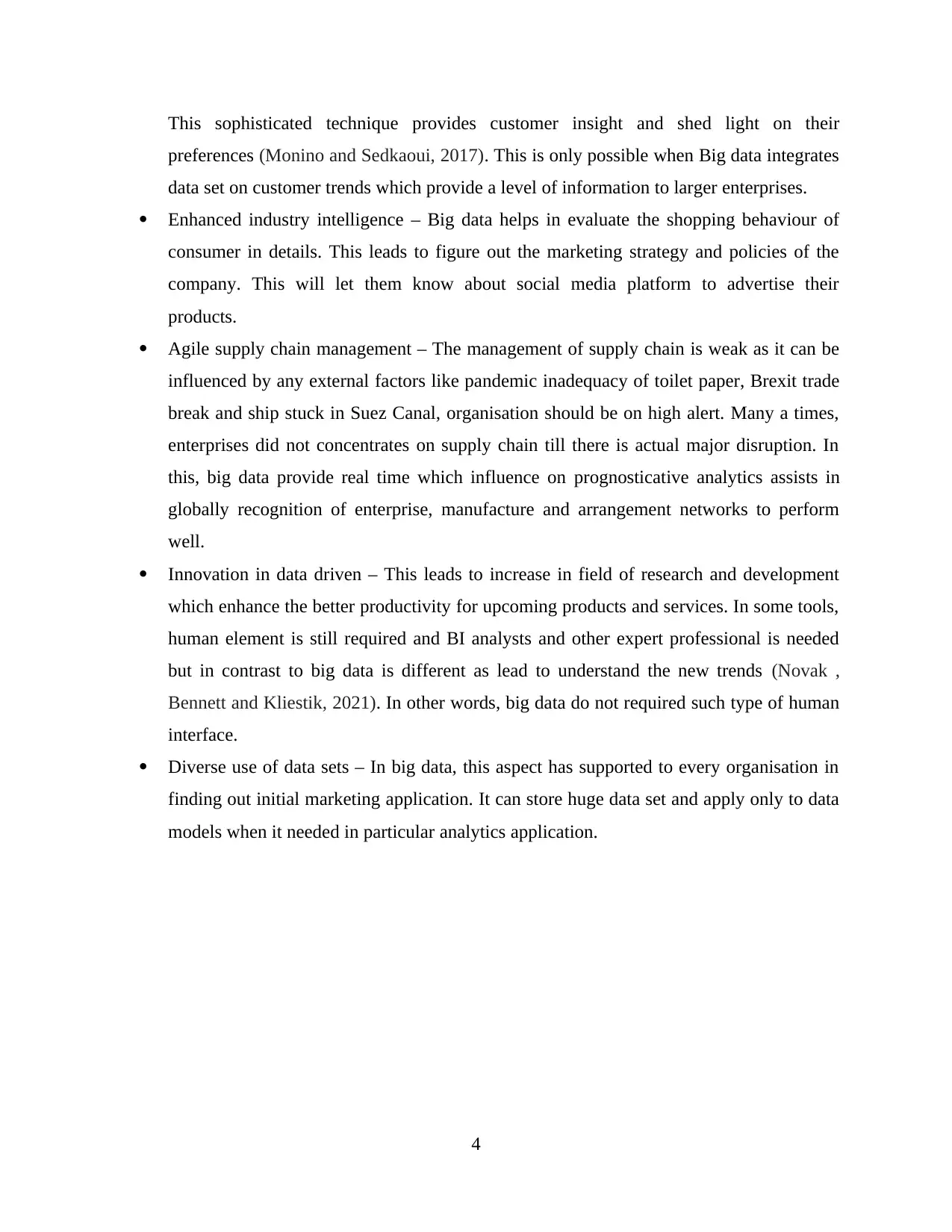
This sophisticated technique provides customer insight and shed light on their
preferences (Monino and Sedkaoui, 2017). This is only possible when Big data integrates
data set on customer trends which provide a level of information to larger enterprises.
Enhanced industry intelligence – Big data helps in evaluate the shopping behaviour of
consumer in details. This leads to figure out the marketing strategy and policies of the
company. This will let them know about social media platform to advertise their
products.
Agile supply chain management – The management of supply chain is weak as it can be
influenced by any external factors like pandemic inadequacy of toilet paper, Brexit trade
break and ship stuck in Suez Canal, organisation should be on high alert. Many a times,
enterprises did not concentrates on supply chain till there is actual major disruption. In
this, big data provide real time which influence on prognosticative analytics assists in
globally recognition of enterprise, manufacture and arrangement networks to perform
well.
Innovation in data driven – This leads to increase in field of research and development
which enhance the better productivity for upcoming products and services. In some tools,
human element is still required and BI analysts and other expert professional is needed
but in contrast to big data is different as lead to understand the new trends (Novak ,
Bennett and Kliestik, 2021). In other words, big data do not required such type of human
interface.
Diverse use of data sets – In big data, this aspect has supported to every organisation in
finding out initial marketing application. It can store huge data set and apply only to data
models when it needed in particular analytics application.
4
preferences (Monino and Sedkaoui, 2017). This is only possible when Big data integrates
data set on customer trends which provide a level of information to larger enterprises.
Enhanced industry intelligence – Big data helps in evaluate the shopping behaviour of
consumer in details. This leads to figure out the marketing strategy and policies of the
company. This will let them know about social media platform to advertise their
products.
Agile supply chain management – The management of supply chain is weak as it can be
influenced by any external factors like pandemic inadequacy of toilet paper, Brexit trade
break and ship stuck in Suez Canal, organisation should be on high alert. Many a times,
enterprises did not concentrates on supply chain till there is actual major disruption. In
this, big data provide real time which influence on prognosticative analytics assists in
globally recognition of enterprise, manufacture and arrangement networks to perform
well.
Innovation in data driven – This leads to increase in field of research and development
which enhance the better productivity for upcoming products and services. In some tools,
human element is still required and BI analysts and other expert professional is needed
but in contrast to big data is different as lead to understand the new trends (Novak ,
Bennett and Kliestik, 2021). In other words, big data do not required such type of human
interface.
Diverse use of data sets – In big data, this aspect has supported to every organisation in
finding out initial marketing application. It can store huge data set and apply only to data
models when it needed in particular analytics application.
4
⊘ This is a preview!⊘
Do you want full access?
Subscribe today to unlock all pages.

Trusted by 1+ million students worldwide

5
Paraphrase This Document
Need a fresh take? Get an instant paraphrase of this document with our AI Paraphraser
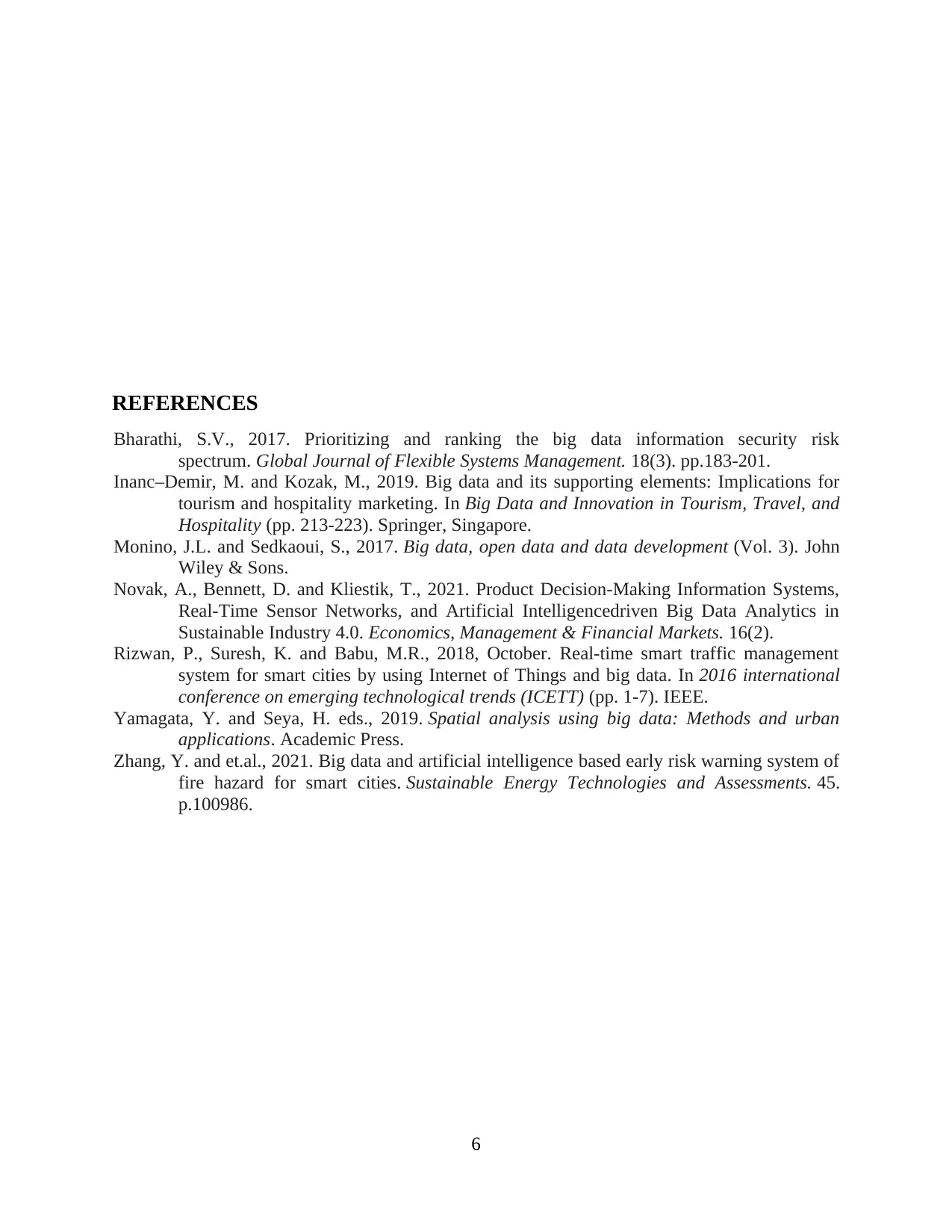
REFERENCES
Bharathi, S.V., 2017. Prioritizing and ranking the big data information security risk
spectrum. Global Journal of Flexible Systems Management. 18(3). pp.183-201.
Inanc–Demir, M. and Kozak, M., 2019. Big data and its supporting elements: Implications for
tourism and hospitality marketing. In Big Data and Innovation in Tourism, Travel, and
Hospitality (pp. 213-223). Springer, Singapore.
Monino, J.L. and Sedkaoui, S., 2017. Big data, open data and data development (Vol. 3). John
Wiley & Sons.
Novak, A., Bennett, D. and Kliestik, T., 2021. Product Decision-Making Information Systems,
Real-Time Sensor Networks, and Artificial Intelligencedriven Big Data Analytics in
Sustainable Industry 4.0. Economics, Management & Financial Markets. 16(2).
Rizwan, P., Suresh, K. and Babu, M.R., 2018, October. Real-time smart traffic management
system for smart cities by using Internet of Things and big data. In 2016 international
conference on emerging technological trends (ICETT) (pp. 1-7). IEEE.
Yamagata, Y. and Seya, H. eds., 2019. Spatial analysis using big data: Methods and urban
applications. Academic Press.
Zhang, Y. and et.al., 2021. Big data and artificial intelligence based early risk warning system of
fire hazard for smart cities. Sustainable Energy Technologies and Assessments. 45.
p.100986.
6
Bharathi, S.V., 2017. Prioritizing and ranking the big data information security risk
spectrum. Global Journal of Flexible Systems Management. 18(3). pp.183-201.
Inanc–Demir, M. and Kozak, M., 2019. Big data and its supporting elements: Implications for
tourism and hospitality marketing. In Big Data and Innovation in Tourism, Travel, and
Hospitality (pp. 213-223). Springer, Singapore.
Monino, J.L. and Sedkaoui, S., 2017. Big data, open data and data development (Vol. 3). John
Wiley & Sons.
Novak, A., Bennett, D. and Kliestik, T., 2021. Product Decision-Making Information Systems,
Real-Time Sensor Networks, and Artificial Intelligencedriven Big Data Analytics in
Sustainable Industry 4.0. Economics, Management & Financial Markets. 16(2).
Rizwan, P., Suresh, K. and Babu, M.R., 2018, October. Real-time smart traffic management
system for smart cities by using Internet of Things and big data. In 2016 international
conference on emerging technological trends (ICETT) (pp. 1-7). IEEE.
Yamagata, Y. and Seya, H. eds., 2019. Spatial analysis using big data: Methods and urban
applications. Academic Press.
Zhang, Y. and et.al., 2021. Big data and artificial intelligence based early risk warning system of
fire hazard for smart cities. Sustainable Energy Technologies and Assessments. 45.
p.100986.
6
1 out of 8
Related Documents
Your All-in-One AI-Powered Toolkit for Academic Success.
+13062052269
info@desklib.com
Available 24*7 on WhatsApp / Email
![[object Object]](/_next/static/media/star-bottom.7253800d.svg)
Unlock your academic potential
Copyright © 2020–2025 A2Z Services. All Rights Reserved. Developed and managed by ZUCOL.

